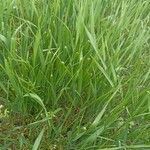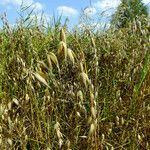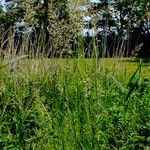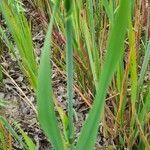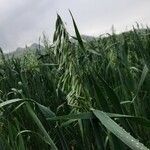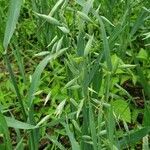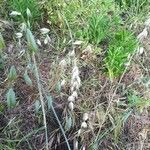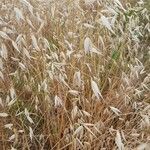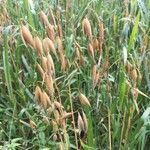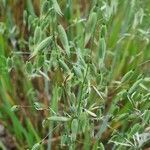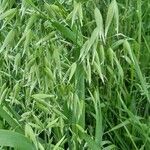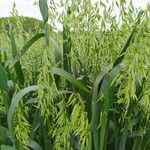Erect, green to glaucous tufts, 50-150 cm. Leaf-sheath glabrous or slightly hairy. Ligule (2)-3-5 mm, ± rounded, finely denticulate, abaxially finely scabrid. Leaf-blade 15-40 cm × (2.5)-7-15 mm, ± finely scabrid on ribs; margins finely scabrid, sometimes with a few scattered hairs. Culm erect or decumbent and rooting at base, internodes glabrous. Panicle 14-32 cm, very variable in shape, loose or contracted, equilateral to secund; branches horizontal to ± erect, slender, finely scabrid. Spikelets (15)-20-30-(40) mm, 2-(3)-flowered, pendulous on fine unequal pedicels; falling intact at maturity. Glumes 9-11-nerved. Lemma 10-18 mm, ovate-lanceolate, glabrous, or with a few hairs towards base, apex obtuse or shallowly notched, red-brown, grey, yellow, white or blackish, usually awnless, but lowest or sometimes all florets in certain cultivars bearing a weak, straight or curved awn, not geniculate and scarcely twisted at base. Palea keels with 1 row of cilia, interkeel scabrid or glabrous. Anthers 2-4.2 mm. Caryopsis 4-9 × 1.5-3 mm.
Annual. Culms solitary or tufted, erect, 40–180 cm tall, unbranched. Leaf sheaths usually glabrous; leaf blades 15–30 cm, 4–10 mm wide, glabrous, margins sometimes scaberulous; ligule 3–6 mm. Panicle loose and open or contracted, 20–40 cm, nodding; branches spreading or contracted. Spikelets 2–3 cm, florets 2(or 3); rachilla ± glabrous, straight, not disarticulating or fracturing irregularly at maturity, florets lacking a basal bearded callus, internodes short, less than 0.5 mm; glumes lanceolate, subequal, as long as spikelet, 7–9-veined; lemmas 1.2–2.5 cm, leathery in lower half, herbaceous and distinctly veined above, glabrous or nearly so, apex minutely and irregularly 2–4-denticulate; awn 2.5–3.5 cm, weakly geniculate or rudimentary or absent. Grain adherent to lemma and palea at maturity. 2n = 42.
Loosely tufted annual, 0.35-1.50 m high; culms solitary. Leaf blade 100-400 x 3-9 mm; ligule an unfringed membrane. Inflorescence an open panicle. Spikelet 17-35 mm long, laterally compressed; glumes ± equal, 7-9-nerved, as long as to longer than spikelet, membranous on margins. Florets 2 or 3, rachilla disarticulating at maturity only above glumes; lemma 5-9-nerved, sparsely hairy or glabrous, lobed; lobes awnless or awned up to 4.5 mm long; central awn longer than body of lemma, with a distinct, twisted column, almost straight, sometimes absent; palea enclosed by margins of lemma, scabrid on keels; callus present on all lemmas; anther 2.0-4.6 mm long. Flowering time Sept.-Nov.
Loosely tufted annual 350-1500 mm high; culms solitary. Leaf blade 100-400 x 3-9 mm. Spikelet 17-35 mm long, 2 to 3-flowered; rachilla disarticulating above the glumes only at maturity; glumes membranous on the margins; lemma sparsely hairy or glabrous, apices emarginated; lobes awnless or awned, awn up to 4.5 mm long, 1-nerved; central awn with a distinct column, almost straight, sometimes absent; palea enclosed by margins of the lemma, scabrid on keels; callus present on all lemmas; anther 2.0-4.6 mm long.
Much like no. 1 [Avena fatua L.], and hybridizing with it; herbage glabrous to scabrous; spikelets 2(3)-fld, the rachilla glabrous or only sparsely hirsute, not readily disarticulating; lemmas glabrous to sometimes scabrous, 3–7-veined, the callus naked or only sparsely bearded; awns, when present, (15–)22–35 mm, then only on the first lemma, not geniculate; 2n=42. European cultigen derived from no. 1, cult. throughout our range and often adventive in disturbed sites, but probably not persistent.
An annual grass plant and cereal with an open spreading flower head. It can grow up to 1 or 1.5 m tall. The stalks are moderately stout. The leaves are narrow and sword shaped. They are flat and 45 cm long by 25 cm wide. The flower arrangement is an open panicle. This is in a head 50 cm long. The flowers are held to one side of the stem. The fruit is a grain tightly enclosed by the glume.
Annual; up to 1.5 m high; solitary or loosely tufted. Leaf blades 100-400 x 3-9 mm. Flowers: panicle open; spikelets 17-35 mm long; lemmas sparsely hairy or glabrous at base; apex emarginate; central awn with a distinct column; almost straight; sometimes absent.
Annual, culms solitary or loosely tufted, up to 1.5 m high. Leaf blades 100-400 mm long, 3-9 mm wide. Spikelets 17-35 mm long; lemma sparsely hairy or glabrous, apices emarginate; awn with a distinct column, almost straight, sometimes absent.
Like A. byzantina but awn with a distinct column, sometimes awnless.
